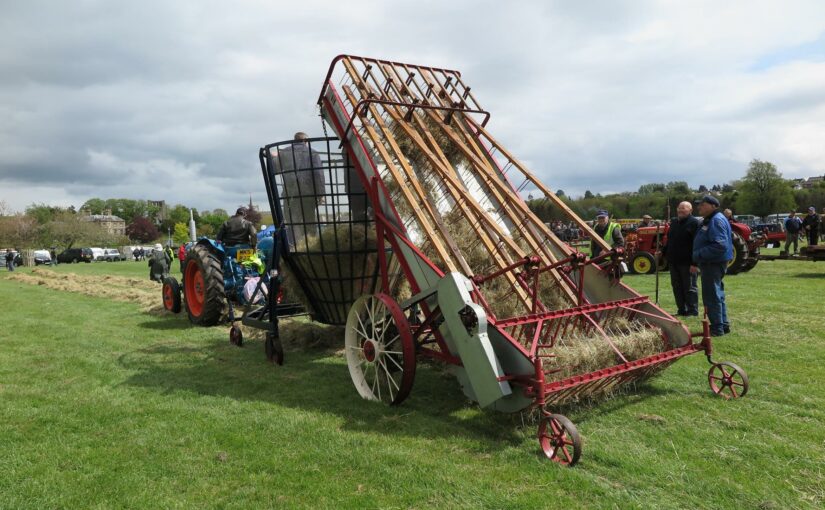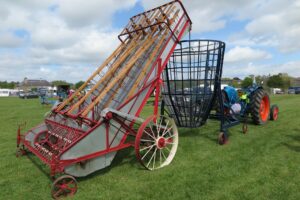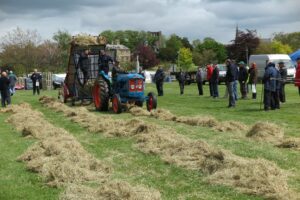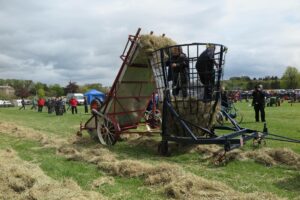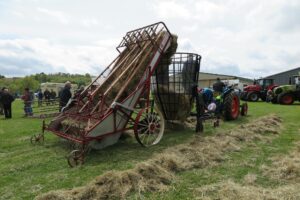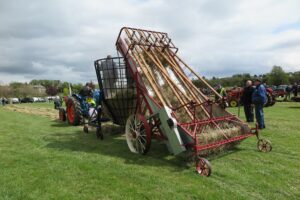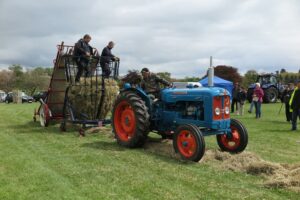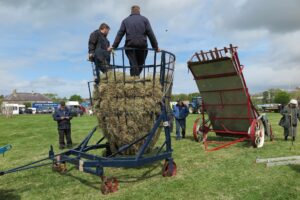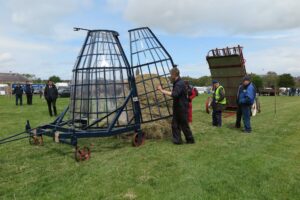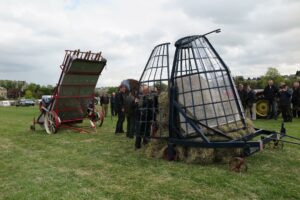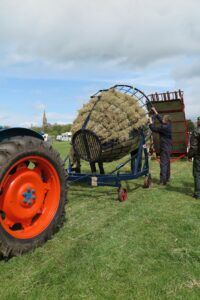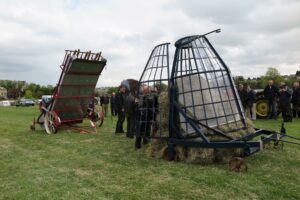In 1921 the Highland Show was held at Stirling. It has a significant display of implements and machines. The Scotsman called this an “imposing display”. It was perhaps even more important than in earlier years because of the importance of mechanization brought out as a result of the First World War and the shortage of agricultural labour. But agriculture was also facing tough times. Economies of man power and mechanization were seen to be important for the success and future success of Scottish agriculture.
The Scotsman usually provided a succinct account of the Highland Show. This year was no different. It set out its account with a reflection on where the Scottish farmer was with mechanization and noted some of the key stands and developments. The years saw some important developments that were to change agriculture significantly: the Paterson rick lifter to make the process of making rucks more labour-efficient on the hay field, and the increasing use of tractors, through for example the Ivel, and the International . Ruck lifters and some of the older tractors can still be seen at rallies in the last few years.
This is what the Scotsman wrote of the Highland Show on 26 July 1921:
“The important position which the implement department has now for many years attained in all the principal showyards of the country is the outcome of the ingenuity, engine, and resourcefulness of the inventive and enterprising agricultural engineer, who has come to the aid of the farmer in every branch of husbandry. In securing the crops of the field the combined reaper and binder has to a large extent supplanted the ordinary mower and reaper; the work of gathering the hay crop in good condition has been greatly expedited by the introduction of mechanical haymakers; tillage operations and the preparation of the land for seed are carried on with the aid of cultivating machinery in every branch of that work; and labour-saving appliances have in an infinite variety of forms been brought to bear in every department of agriculture. The modern farmer has thus at his hand all the necessary equipment for carrying on high-class farming on the most appropriate principles. And the end is not yet, for the agricultural implement industry is now one of great magnitude, and every year sees some fresh development in its projects with a view to still further alleviating the position of the farmer. It is fitting therefore that while the encouragement of stock-breeding should receive the greatest prominence at the hands of the Highaldn and Agricultural Society, due regard should also be paid to the value of the work that is being done by the agricultural engineer in the economy of the farm. That he is still striving after new improvements and fresh methods in order to reach an even higher stage of perfection is shown by the large and comprehensive display of implements of every description that is to be seen in the Highland and Agricultural Society’s showyard at Stirling this week. Although there may not be much of a strikingly novel character to be found in the numerous lots of stands, there is an assortment of articles adapted not only to the ordinary work of the farm, but to the special purpose for which machinery has of late years been designed. Tractors are conspicuous.
“New implements”
The implement yard occupies 7200 feet, 1000 feet more than at Aberdeen last year, and all this space has been fully taken up by the machinery and implement manufacturers, the entries in this section being the largest in the history of the Society. Only 22 implements were shown at the first Highland Show in 1833, and they were still under 100 in 1864, but they reached four figures in 1873. In 1881 they numbered 2000, and that has been about the acreage extent of the department ever since. This week’s number is 2201, being 136 more than at Aberdeen last year. Great activity was shown on all stands to-day, and the various exhibits were being brought forward in good time. The implements stands were, despite the rain, being pushed on so as to be in readiness for the opening to-morrow.
Fourteen exhibitors have entered sixteen “new implements” for competition for the Society’s silver medal. The Society does not bind itself to try in the field every new implement, but an exhibitor who expresses a wish to do so can, with the sanction of the steward of implements, at his own expense take his new implement out of the showyard during the show week, and put it to work, and if within a reasonable distance, the judges will, if they deem it necessary, inspect it at work and decide if it is worthy of a silver medal. The judges of new implements are Messrs A B Leitch, Inchstellie, Alves, Forres; John Speir, Newton, Glasgow; and G. Bertram Shiels, Dolphingstone, Tranent; and they begin their work to-morrow.
Newly designed mowing machine
Messrs Armstrongs & Main (Limited), Edinbrugh, have entered a newly designed grass mowing machine, the “Viking”, containing details of construction not previously embodied in the manufacture of similar labour-saving machines. The new principle in this machine is that of spiral gearing which has been subjected to severe tests during the past four years. The new gearing, which has hitherto been used in the construction of motor cars, is now introduced into harvesting machines for the first time, and in consequence greater power, reduction in draught, sweetness in running and greater durability are produced.
Sir W G Armstrong, Whitworth & Co., exhibit a 3hp oil engine which has been specially designed for agricultural and general purposes. The engine is of a compact nature, taking up little space. All the working parts are enclosed, with the exception of the fly-wheel, pulley, and the ends of the crank shaft. The necessary for external lubrication has been eliminated.
Sheep drain cleaning machine
For many years hill farmers have been looking out for a serviceable sheep drain cleaning machine. The Craigrossie Engineering Co., Auchterarder, have come forward with a machine invented by Mr Jas Parker Smith, Eastmill, Auchterarder, which is made to clean sheep drains measuring up to 22 inches wide on the surface by 14 inches deep, with a drain bottom of 9 inches wide.
The soil is cut by disc coulters on either side, and the bottom is cut by a steel shave, and the whole soil cut comes to a stationary steel conveyor 7 feet long, which is set with a gradual rise to a height of about 3 feet at the rear, when the soil falls on to an inclined steel plate set at right angles to the conveyor, and which deposits the soil 3 feet from the side of the drain. The machine is built on three wheels. One front swivel wheel runs in the drain, and is raised and lowered by a lever, as desired; and two rear wheels, 28 inches in diameter, with a live axle which drives a top chain conveyor. The whole machine machine is carried on two parallel bars, 20 inches wide, and to which the front and rear wheels are attached.
Turnip thinner
Mr James H. Steele, 61 Harrison Road, Edinburgh, has entered a new patent turnip thinner made by Corbett, Williams & Son (Ltd), Flintshire. This is an implement for thinning roots at 10 in, 12 in, or 14 in pitch, on drills varying from 22 in to 28 in apart. The working depth is regulated by hand levers on each side of the machine, which raise or lower the thinning apparatus, which consists of a revolving helical knife in conjunction with two flat superimposed segments. These segments are moved along the shafts longitudinally, and adjusted radially to suit the width of that portion of the drill which it is proposed to remove. The pitch or lead of the revolving helicoid, being quicker than the travel of the machine, has a tendency when it enters the earth to throw it in a backward direction, whereas the flat segment, traveling at the same rate as the machine, when revolving, has a tendency to throw the earth forward, with the result that the apparatus starts its cutting action at each end of the space to be removed, and finishes its cut midway between.
Farm engine
Messrs Wallace (Glasgow) Ltd, Dennistoun, Glasgow, exhibit a 2 ½-3 bhp stationary single sleeve valve engine. It is air cooled and a model of neatness. The principal feature is simplicity, having 70 per cent fewer parts than the usual type of small farm engine. It has two-speed drives, a high speed of 1000 revolutions per minute, and a slow speed of 500 revolutions per minute. The fuel is paraffin. Although the engine is listed 2 ½-3 bhp dynanometer tests have recorded 4.25 bhp, so that there is a considerable margin of power.
Hay ricker
Messrs Robertson & McLaren, Craigmill, Stirling, have entered the “Victory” hay ricker, invented by Mr Geo, Paterson, farmer, Wester Frew, Kippen. It is an implement for collecting and ricking hay, and though its present price may be prohibitive for the ordinary farmers, it has many points in its favour, chief of which is labour saving. Driven by two horses, the implement goes between the swathe, and the hay is carried by an elevator from the ground to a steel cage, inside of which is a man who tramps the hay. When the cage is full the man comes out, and the cage is inverted, allowing the rick to fall to the ground. The implement is said to have been in use by farmers in the Stirling district, who have found it a serviceable aid to haymaking.
Expanding horse how
Mr A M Russell, Edinburgh, exhibits an expanding horse hoe, invented by Mr Ernest William Brown, and made by George Brown & Son, Leighton Buzzard. This hoe is made with an improved expansion, so that all tines are made parallel, no matter what position they are expanded to. Another improvement is the construction of the steel tines, which demands of 19 different feet being fitted interchangeably by one bolt.
The motion yard
Year by year, as science becomes more and more the handmaid of agriculture, the Motion Yard at the Highland Show grows in interest. Again there is an imposing display of all sorts of appliances to aid the farmer. To the town visitor unacquainted with farming such an array of machinery must come as something of a revelation, telling him that the tilling of the soil is not the primitive, simple operation he had deemed to be. Gas and oil have been called into supply motive power for the modern complex machinery. Nor is the wind’s aid discarded, but the present windmills are vastly superior to the old-fashioned sort with the far-spreading arms. The vast array of motors in many forms are a special feature of the exhibition. Turning to the left after passing through the main entrance at Victoria Place, the visitor to the Show comes at once upon the Motion Yard, which is easily found, betraying its locality, as it does, by the noise and clangour of wheels and pistons. The agriculturists on the outlook fore mechanical aids in his industry and the casual visitor will alike find much in this section to interest and instruct.
Scottish Motor Traction Co’s exhibit
Farm tractors and engines are included in the attractive display by the Scottish Motor Traction Co. (Ltd), Edinburgh. The agricultural tractors shown are the well-known “Titan” and “International Junior”, one of the former variety being of 20hp, and two of the latter of 28.9hp. The worth of these machines has been adequately demonstrated in recent years, and their adaptability and value are manifest to the farming community. These tractors are manufactured by the international Harvester Company of Great Britain (Ltd), whose paraffin engines and other agricultural implements are also on view at this stand. Two interesting exhibits are the “International” 3-furrow self-lifting tractor plough, with rolling disc coulters and adjustable mould boards, and an “International” ensilage cutter, with a capacity of 12 to 15 tons per hour. In view of the growing interest in ensilage in Scotland, this machine will be noted with interested. The stationary oil engines shown are complete with skids and tools. The Company hold numerous agencies for private motor cars of first-class design and manufacture, and also supply commercial motor vehicles of the latest and most approved design.
“Glasgow” tractor
Messrs Wallace (Glasgow) Ltd, display a representative collection of farm implements and machinery. The two outstanding features of their exhibit are the “Glasgow” tractor and the “Glasgow” single sleeve valve farm engine. Alike from an engineering and a farmer’s point of view the former has already thoroughly commended itself. The “Glasgow” tractor, having a three-wheel drive, transmits its power to the drawback in such measure that the manufacturers claim its greatest success is exactly where others fail-viz, under heavy conditions and on hilly land. A novel method of showing the drawbar merits of the “Glasgow” tractor is on view in the form of a large clock-like face showing the drawbar pull necessary for a two-furrow and likewise for a three-furrow plough, and further , round the dial the hand points to the drawbar pull of the “Glasgow”, showing a big reserve over what is necessary for a three-furrow plough. The single sleeve valve farm engines, which are on view for the first time at the Highland Show, are referred to under the heading of new implements. Arrangements are well forward in the factory for a large output. Messrs Wallace’s collection of their well-known specialities also includes two electric lighting sets, mowers and reapers, a potato digger, and a planter and manure sower.
Edinburgh firm’s display
With “Everything for the Farm”, as a motto, Mr James H. Steele, Edinburgh, has an excellent display of useful implements. A British Wallis tractor, fitted with special wheel studs for road haulage and other improvements, occupies a prominent place, and among new machines that also catch the eye ate the Corbett-Williams new patent root thinner, Gratton’s patent dry powder sprayer for potatoes, and Charlock & Coultas’s new manure sower for either wet or dry manures; McKenzie’s power root cutter and Edlington’s power potato sorter, Ruston & Hornsby’s new paraffin engine, binders, mowers, corn drills, trussers, Albion harvesting and barn machinery, Richmond & Chandler chaff cutters, cake mills, Petter engines, Don distributors, &c; Ransome’s tractor and horse ploughs, rakes, and potato diggers, new pattern horse fork for open or shed work, and other useful farm tools. Among the smaller goods, the “Perfect” sheaf band cutter is a useful article, the points of which every farmer who has a threshing mill will be interested to observe.
Milling machines
The Scottish Agricultural Engine and Machine Company have an interesting display of the latest types of machines suitable for farmers and millers. Simple in design, they are also effective in use. There are ten milling machines on view, five crushers, and a double stroke oil engine is also among the specialities exhibited. It is claimed for some of the milling machines that they grind all kinds of grain for table use, as well as for cattle feeding; shell oats, grind oatmeal, and refine pot barley from rough barley.
Some Scottish stands
A glance at some of the other stands in this interesting section of the yard finds Scottish firms well represented. Threshing machines are included in the exhibits forward from David Page & Son, Milnathort, and Wm Baird & Co., Lasswade; and Henderson Bros, Stirling, and Auchterarder have a display of Fordson tractors and various types of Ford cars and trucks. The Ladyacre EngIneering Co., Lanark, are showing their threshing mill amongst other useful exhibits, and R. & T. Wyllie, Heugh, North Berwick, include a traction engine made by John Fowler & Co. (Ltd), Leeds. Stationary oil engines are exhibited by Alexander Shanks & Son (Ltd), Arbroath, and A. Laurie & Sons, Camelon, Falkirk, are showing end and side tipping waggons and trailers. Accessories for road making and quarrying are included in an interesting display by Fleming & Co., Robertson Street, Glasgow. A variety of engineering specialities are shown by J. R. Forrester, Paisley, including Molesley petrol engines, cream separators, and sheep shearing machines; and the Bon Accord Engineering Co (Ltd), Aberdeen, have forward a selction of the mills and implements in which they specialize. Lime washing and spraying machines are shown by Marshall & Philp, Aberdeen, and the “Samson” windmill is included in the display by John S. Millar & Son, Annan. James Crichton, Strichen, and Ford & Paterson, Broughty Ferry, have threshing machines in their stands, while the well-known “Handy” ricklifter showing all the latest improvements, is forward from William Dickie & Sons, East Kilbride. Oil engines from 3 1/2bhp to 23 bhp are shown by Allan Bros, Aberdeen. P. & R. Fleming & Co., Glasgow, have again a comprehensive display of agricultural machinery and implements, including the Case tractor in motion. P. & W. Maclellan (Ltd), Glasgow, are showing “Super Clutha” and “Clutha” steel windmills.”
The photographs were taken at the Borders vintage rally, May 2015.
